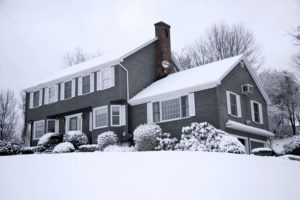Winter Maintenance Tips For Your Home
Severe winter weather can cause significant damage to your home; some estimates find that winter storms cause more than $1 billion in damage each year. To avoid costly repairs this winter, help prepare your home for winter weather with these five tips.
 1. Inspect your fireplace
1. Inspect your fireplace
Whether you have a fireplace as a primary heat source or use one to supplement the furnace on cold days, regular chimney maintenance is extremely important. A fireplace sweeping and inspection can keep your fireplace burning safely and efficiently all winter long.
During a fireplace sweeping, the chimney sweep will remove soot, ash, and flammable creosote from the flue. In addition to preventing chimney blockages and allowing the chimney to draft effectively, removing creosote is extremely important in preventing chimney fires. Because it is so flammable, creosote buildup in the flue can be accidentally ignited by stray sparks or embers from the fireplace; removing creosote through annual chimney sweepings can reduce the risk of a chimney fire occurring.
As part of the chimney inspection, the chimney sweep will assess all interior and exterior portions of the chimney. This allows them to check for signs of damage or deterioration, such as:
- Damage to or missing chimney cap
- Signs of animal entry
- Tree limbs or branches overhanging the chimney
- Cracked or crumbling chimney masonry
- Loss of watertight seal on chimney flashing
- Staining on or around the chimney
- When caught early, chimney damage can be easily repaired by a skilled chimney technician.
2. Seal leaky doors and windows
Gaps around doors and windows can allow cold air to seep into your home during winter months. In addition to creating cold pockets in your home, this forces your furnace to work harder to keep your home at a consistent temperature. According to the US Department of Energy, reducing drafts can help reduce energy costs by up to 20% during winter months.
Adding new weatherstripping is an easy way homeowners to stop conditioned air from seeping out of their home. There are a variety of weatherstripping choices available, each with their own pros and cons.
- Bronze weatherstripping. Bronze weatherstripping is extremely durable and can last for decades. However, it is pricier than other options – and can be time-consuming to install.
- Self-stick plastic weatherstripping. Extremely easy to install, self-stick plastic weatherstripping needs to be replaced often.
- Adhesive-backed EPDM. This type of weatherstripping is more durable than self-stick plastic but is easier to install than bronze. Most EPDM weatherstripping can last for up to 10 years.
- Don’t forget to seal around the exterior of doors and windows with latex caulk!
3. Keep pipes from freezing
Consistent temperatures below zero can wreak havoc on plumbing systems – especially for exterior pipes. While constantly moving water and warmer interior temperatures helps protect interior plumbing, exterior pipes are prone to cracking. In addition to releasing hundreds of gallons of water in a single day, the leaks from cracked pipes can lead to serious structural damage to a home.
Begin by shutting off external pipes at the beginning of winter. Check pipes again after a few days to ensure they have fully drained and to flush any remaining water out of the system. Consider wrapping insulating tape around any exterior pipes or pipes in basements or crawlspaces to help prevent cracks. Likewise, invest in exterior faucet covers to cover and project exterior spigots.
4. Clean the dryer vents
In winter it is too cold to dry laundry on the line or on a rack; this often leads to dryers being used more. Ensure your dryer is operating safely and efficiently by having the dryer vents cleaned.
Each year, more than 15,000 house fires are caused by clogged dryer vents. When dryer vents become clogged, dryers may stop operating efficiently, take longer than 1 cycle to dry, create excessive lint, or have lint that is visible from exterior vents.
To reduce the risk of a dryer fire, vents should be cleaned once per year. This is especially important for homes or buildings with longer dryer vents; the longer the dryer vent has to stretch, the more lint can become trapped inside.
5. Prevent ice dams
In areas of the country like Minnesota, significant snowfall is a part of life during the winter. Protect your roof from damage by helping prevent ice dams from forming. Ice dams form at the edge of the roofline and prevent melting snow from draining.
Ice dams form on the roof when warm air in the upper floors or attic melts snow or ice on parts of the roof – but not the eaves. As this snow melts prematurely, it freezes again on a colder part of the roof, such as the eaves; this creates the ice dam that can back up the flow of melting water and lead to roof damage.
There are several ways that ice dams can damage the roof. First, backed up water can sit on shingles, leaking through the roof and onto insulation and drywall. Ice dams also put downspouts and gutters at risk; because they sit at the edge of the roofline, a large ice dam can pull gutters down with it if it falls.
Ice dams can be carefully removed by breaking away small chunks at a time or using tools such as a rake or shovel to remove snow from the roof after a storm. However, the best solution to ice dams is to address the underlying cause: parts of the roof where snow melts too quickly due to leaking warm air. Adding insulation, keeping all parts of the home a consistent temperature, and preventing air leaks in the attic can all help prevent ice dams from forming.
At Jack Pixley Sweeps, we are used to dealing with cold Minnesota winters! Contact us today for information on how we can prepare your fireplace and chimney for the winter.
